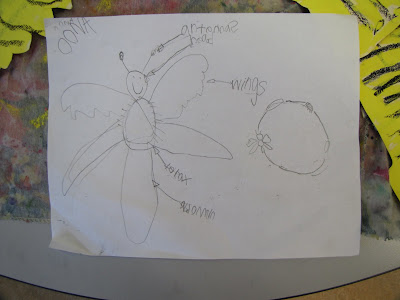
Cleveland Elementary Arts Coordinator: Michelle Windell
Kindergarten and First Grade / 12-week program
An in-depth project constructing honey bees and flowers out of (mostly recycled*) paper. Students learned basic anatomy of bees, their role as pollinators, basic anatomy of flowers, and the concept of pollination being necessary for the formation of seeds, fruits and vegetables.
Some of the art skills developed were: discerning and creating shape, composition, pattern, line, form, color nuances, and two- and three-dimensional form. There were several small projects over the course of the residency to teach specific lessons in line, pattern, drawing, cutting, painting, oil pastels, layering of art materials, and more. The kids performed theater pieces in class enacting the dance that bees actually do to communicate the location of flowers.
In addition to the art concepts, this program included many science, math, and writing concepts such as small animal and plant anatomy, pattern, addition, symmetry, and writing bee-related terms in English or Spanish. The students learned the main body parts of bees: head, thorax, abdomen, eyes, antennae, proboscis, pollen sacs, and veins (and their function) in the wings. They understood how and where those body parts were connected, and the fact that the fur on the bees’ legs and bodies serves as a carrier of pollen from flower to flower. They learned the major parts of flowers: petals (and their veins), the center of the flower where pollen is and seeds form. They experienced the scent of real orange blossoms in a demonstration of the way scent attracts bees. They learned and performed the dance that bees do to communicate to their co-workers the location of nectar sources (flowers), and enacted their bees buzzing from flower to flower collecting nectar and pollen. They also became clear on the fact that bees make honey in their hives using the nectar that they collect from flowers.
Over the 12-week program, the classroom teachers and I revisited the art techniques, science concepts, and math concepts that are connected to bees, pollination and flowers. The teachers incorporated the project into their classrooms through writing, reading, and math. Ms. Huerta (Kindergarten, bilingual Spanish) had her students write sentences about bees on a large poster which she displayed in the classroom, along with a labelled bee diagram. Ms. Baker-Cohn (First grade, English) read a beautiful poem in English and then in Spanish about beehives in Guerrero, Mexico; she also had her students draw hexagons, a reference to the honeycomb and also to math concepts. Ms. Eros (First grade, English) had her students write stories about bees. They and the other teachers also did other activities related to bees. For the school's special Art Show Night, the teachers hung all of the bees in the 2nd floor elevator vestibule in a giant "beehive" installation, complete with large hexagons drawn on wax paper by the kids to simulate a honeycomb.
The students had fun, learned to appreciate bees and their important role as pollinators, and also improved their own team-building and social skills. In addition, they were presented with basic concepts of plant and animal interdependency, which will be revisited in their 2nd and 4th grade science studies. A favorite moment of mine was overhearing 1st graders playing with the plastic shape manipulatives in their free time--they were arranging hexagons into honeycombs.
Note:
*The paper used in the bees consisted of discarded manila file folders and plastic sheet protectors which I obtained at San Francisco’s SCRAP (Scrounger’s Center for Reusable Art Parts
http://www.scrap-sf.org/). The flowers were made from expired monthly calendars from the San Francisco library. Re-purposing these materials prevented the sheet protectors from ending up in the landfill, and conserved the energy and resources that would have been used in recycling the folders and calendars. This reinforced in the students the sense that we can re-use and repurpose materials. Additionally, they learned to correct their mistakes on the paper I gave them instead of starting over, a basic teaching approach I always use.


















